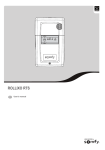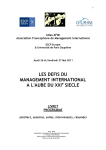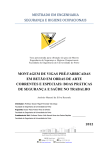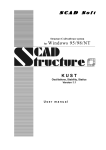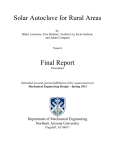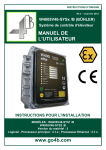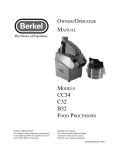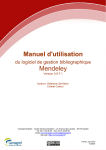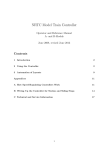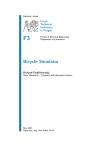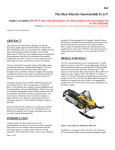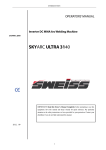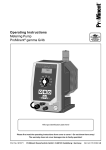Download Electronic Luggage Follower (ELF) - Florida International University
Transcript
Florida International University Department of Mechanical and Materials Engineering Electronic Luggage Follower Submitted By: Adam Stredel Cesar Nunez Maria V. Level Faculty Advisor: _____________________ Dr. Sabri Tosunoglu 11/28/2007 Table of Contents Table of Contents................................................................................................................1 Table of Figures ....................................................................................................................3 Problem Statement: ............................................................................................................5 Project Concepts: ...............................................................................................................5 Objectives: ...........................................................................................................................5 Form and functionality: ......................................................................................................6 Challenges: ..........................................................................................................................7 Clients intended: .................................................................................................................8 Literature Review ....................................................................................................... 8 Books: ............................................................................................................................. 8 Text books: ..................................................................................................................... 9 Internet Articles: ............................................................................................................. 9 Website: .......................................................................................................................... 9 Project Statement: ............................................................................................................10 Design Specifications: ......................................................................................................11 Robot Components ..........................................................................................................12 Wheels: ......................................................................................................................... 12 Ultrasonic Sensor:......................................................................................................... 13 Motor: ........................................................................................................................... 15 Battery:.......................................................................................................................... 16 Programming: ............................................................................................................... 18 Chassis and Fasteners: .................................................................................................. 18 Functional Analysis ............................................................................................................19 Hazards and Failure analysis ...........................................................................................21 Engineering Analysis Summary........................................................................................23 Study Cases ........................................................................................................................29 Thermal Analysis:......................................................................................................... 29 Force Analysis: ............................................................................................................. 34 Drop Test: ..................................................................................................................... 41 Gear Analysis: ....................................................................................................................45 Velocity Analysis:......................................................................................................... 46 Torque/Force Analysis:................................................................................................. 47 Programming of the E.L.F. ................................................................................................49 Pre-set of Robot: ........................................................................................................... 49 Programming the First Robot: ...................................................................................... 50 Testing the First Program: ............................................................................................ 50 Buying the Parts:........................................................................................................... 51 Testing One Ultrasonic Sensor: .................................................................................... 52 The Pieces Arrived: ...................................................................................................... 54 Trying to Simulate the Circuit: ..................................................................................... 54 Using Two Microcontrollers:........................................................................................ 55 Analyzing the Inside of an Ultrasonic Sensor: ............................................................. 56 First Proof of the Theory: ............................................................................................. 56 Failure of the Theory: ................................................................................................... 57 Installing a Manual System: ......................................................................................... 57 Circuit Analysis: ..................................................................................................................58 Assignment Distribution ....................................................................................................61 Table of Figures Figure 1 VEX Polyurethane wheel.............................................................................................. 13 Figure 2 Vex Robotics Ultrasonic Range Finder. ...................................................................... 15 Figure 3 Vex Motor ...................................................................................................................... 16 Figure 4 Vex Labs Power Pack ................................................................................................... 17 Figure 5 Vex Labs Robot Starter Kit............................................................................................ 18 Figure 6 Base of the ELF .............................................................................................................. 24 Figure 7 Base Structure of the ELF.............................................................................................. 24 Figure 8 Wheels used in the ELF ................................................................................................. 24 Figure 9 Motor used in the ELF ................................................................................................... 25 Figure 10 Microcontroller of the ELF .......................................................................................... 25 Figure 11 Ultrasonic Sensor of the ELF ....................................................................................... 26 Figure 12 Battery used on the ELF.............................................................................................. 26 Figure 13 Upper Part of the Luggage ....................................................................................... 27 Figure 14 Inside Shelves of the ELF............................................................................................. 28 Figure 15 Inside Shelves of the ELF............................................................................................. 28 Figure 16 Thermal Analysis on the Base of the ELF (Aluminum Alloy 2014)........................... 30 Figure 17 Thermal Analysis on the Base of the ELF (Plastic ABS) ............................................ 31 Figure 18 Thermal Analysis on the Base of the ELF (Wood) .................................................... 32 Figure 19 Thermal Analysis on the Battery of the ELF .............................................................. 33 Figure 20 Force Analysis Deformation on the Base of the ELF (Aluminum Alloy 2014)........ 35 Figure 21 Force Analysis Displacements on the Base of the ELF (Aluminum Alloy 2014) .... 36 Figure 22 Force Analysis Stress on the Base of the ELF (Aluminum Alloy 2014) .................... 36 Figure 24 Force Analysis Displacements on the Base of the ELF (Plastic ABS) ..................... 38 Figure 23 Force Analysis Deformation on the Base of the ELF (Plastic ABS) ........................... 0 Figure 25 Force Analysis Stress on the Base of the ELF (Plastic ABS)...................................... 39 Figure 26 Force Analysis on the Inside Shelter of the ELF ........................................................ 40 Figure 27 Force Analysis on the Inside Shelter of the ELF ........................................................ 41 Figure 28 Force Analysis on the Inside Shelter of the ELF ........................................................ 41 Figure 29 Drop Test Deformation on the Base of the ELF (Aluminum Alloy 2014) ................ 43 Figure 30 Drop Test Displacement on the Base of the ELF (Aluminum Alloy 2014).............. 43 Figure 31 Drop Test Stress on the Base of the ELF (Aluminum Alloy 2014)............................. 44 Figure 32 Drop Test Deformation on the Base of the ELF (Plastic ABS) ................................. 45 Figure 33 ....................................................................................................................................... 49 Figure 34 ....................................................................................................................................... 53 Figure 35 ....................................................................................................................................... 53 Figure 36 ....................................................................................................................................... 54 Figure 37 ....................................................................................................................................... 55 Figure 38 ....................................................................................................................................... 55 Figure 39 Transmitter Circuit System Draft................................................................................. 59 Figure 40 Transmitter Circuit System Draft................................................................................. 60 Problem Statement: Faculty Advisor: Team Members: Dr. Sabri Tosunoglu Adam Stredel Maria Level Cesar Nunez Project Concepts: The Electronic Luggage Follower A luggage that will follow the user throughout any flat surface without the need of the user to use force to drag it. No effort will be applied by the user in order to carry different load magnitudes. Objectives: • A product easy to be use and to be manageable by any person. • A wireless system made of a transmitter part and a receiver part connected to the luggage. • An optional way to carry the luggage in case of any problem. • A structure and based design to resist load, different temperatures, and external forces. • A luggage with an attractive and innovative exterior design. • A security system that the user can be free of worries of his or her luggage being stolen or left behind. Form and functionality: The product comes in the same sizes as any standard luggage. The system inside the bags is resistant to any load or external force. The luggage functions with several different sensors, ultrasonic sensor and touch sensor. These sensors prevent the bag from bumping onto obstacles, such as people, wall, and other things on the floor. The form of the upper part of the luggage is made round to allow aerodynamics. The based form follows the upper part producing a sense of surface smoothness. Inside the base, all the components are arranged on the back part in a stable and practical way. The functionality of the luggage as said before is to follow a person in either a manual or a wireless way. Ultrasonic sensors are in charge of the wireless function of the luggage. Touch sensors are used to manually drag the luggage. Challenges: Dragging a heavy luggage causes a strain on the person’s body and discomfort too his/her day. The product being developed will end the discomfort of having to drag luggage all around any flat surface. It will also eliminate luggage being left behind, or stolen. The concept was developed by New York architect Peter Yaedon. However his design has not been developed and does not yet met airline requirements. The challenges of ELF can be classified in two; the wireless design and the easily drag design. For the wireless system, the challenge is to achieve the physical separation of an ultrasonic sensor. Ultrasonic sensors are sensors where the transmitter and receiver work together as a one piece. Originally the transmitter sends a signal that bounces in any surface and then is received by the receiver. The lap of time in recorded and the distance is estimated. Separate this sensor is our biggest challenge. Once the physical separation is achieved, another challenge appears. The sensor should estimate the distance according to the magnitude of the feculence instead of the time that takes the signal to leave and return to the sensor. For the easy to drag system, the challenge is based on the accuracy of the manual command. The user will use a rope to “drag” the luggage. By using touch sensors, the rope will be an activator for motion. As the rope is moved to either left or right, the luggage will rapidly move to the corresponding side so that no force is required by the user. The biggest challenge in this system is to control the forward and stopping motion. As the user pulls the rope a little, the sensor must be activated and the luggage must go forward. Clients intended: This product can apply to anyone and everyone that has the need of dragging a luggage on a flat surface. However, to be specific, the follower bag may be directed exactly to women, old people, kids and lazy or busy people. The objective is to drag a luggage using no force at all, that is why our clients are based on weak people. Busy people are also taken into account since most of the time they have their hands busy, whether it is with cell phones, books, or anything else. Literature Review Books: • Choudhury, Maroof Haider. A multi-sensor sonar system for indoor range measurement as a navigational aid for the blind. Green Library General Collection 2003. • Jorge Blanch. Control of mobile robotic platforms by handheld devices. Green Library General Collection. 2003. • Helmers, Carl T. Robotics age in the beginning. Ed Hayden. 1983 • Robillar, Mark J. Microprocessor Based Robotics. Ed. Howard W. Sams & Co. Inc. 1983 • Patel, Patt. Introduction to Computing Systems. Ed. MacGraw Hill. 2004. Text books: • Joseph Shigley, Charles Mischke, and Richard Budynas. Mechanical Engineering Design 7th Edition. New York, NY. McGraw Hill, 2004 Internet Articles: • Carlo Innocenti. “Forward Kinematics in Polynomial Form of the General Stewart Platform.” Journal of Mechanical Design 123.2 (2001). <http://scitation.aip.org/getpdf/servlet/GetPDFServlet?filetype=pdf&id=J MDEDB000123000002000254000001&idtype=cvips> • Neng Tung Liao, and Jen Fin Lin. “A New Method for the Analysis of Deformation and Load in a Ball Bearing With Variable Contact Angle.” Journal of Mechanical Design 123.2 (2001). <http://scitation.aip.org/getpdf/servlet/GetPDFServlet?filetype=pdf&id=J MDEDB000123000002000304000001&idtype=cvips> • Yangmin Li, and Yugang Liu “Real-Time Tip-Over Prevention and Path Following Control for Redundant Nonholonomic Mobile Modular Manipulators via Fuzzy and Neural-Fuzzy Approaches.” Journal of Dynamic Systems, Measurement, and Control 128.4 (2006). <http://scitation.aip.org/getpdf/servlet/GetPDFServlet?filetype=pdf&id=J DSMAA000128000004000753000001&idtype=cvips> Website: • http://www.yeadon.net/yeadon/support/projects/projects.html • http://en.wikipedia.org/wiki/Sensor Project Statement: The Electronic Luggage Follower It is a luggage that by using sensors will follow the user wherever he/she needs to go to make life time a lot more comfortable. The product needs to be practical to human usage. It needs to have a system that allows one luggage to identify the user in order to follow him/her. It also needs to have a built-in security system that prevents the luggage from being stolen or left behind. The luggage functions with a battery so that no plug in is necessary. It needs to be able to read where there are any obstacles and prevent from running into them. It also needs to recognize when and how it needs to make a turn. The luggage functions with ultrasonic and touch sensors. These sensors will work to recognize what path the user is taking and at what speed he/she is walking. The user will have a belt clip or an ankle bracelet with three sensors that will produce or transmit a constant signal. There will also be three more sensors that will record this path and speed and send the information to the microcontroller in the bag which will activate the motor to move the bag where it needs to go. Design Specifications: • Length: 25.984 in (66 cm) • Width: • Height: 18.110 in (46 cm) • Weight: 22.046 lb (10 Kg) Maximum • Battery Access: from the down face of the bag. • Assembly: Allen hex screws • Battery: Vex 7.2V Ni-Cad Battery • Run Time: About 4 hrs • Drive: 4 wheel drive • Wheel Composition: Polyutherane • Wheel Diameter: 9.842 in (25 cm) 2.756 in (7 cm) • Wheel width: 0.787 in (2 cm) • Steering: • Translate max speed: • Material: Nylon (Casing) & Polypropylene (Base) 360o steering allowed for each wheel 6 ft/s Robot Components There are a series of components that need to be taken in consideration while building an automated luggage. The parts may include, sensors, microcontroller, motors, gears, batteries, Nylon for the casing, among other things. All these factors are very important in putting this luggage together. Wheels: Wheels need to have very low friction, so that there is no resistance while the ELF follows the user. Polyurethane wheel are used, similar to those on roller blades, as shown in Figure 1. The polyurethane composite is mounted on a hard plastic called polypropylene. These wheels can be used in any flat or almost flat surface. Figure 1 VEX Polyurethane wheel. For our purpose, we could use a 2.756 in diameter wheel. Ball wheels, which can rotate in any direction, are also used for the back part of the luggage. These wheels may help us distribute the weight of the luggage and its load without interfering on the direction of the robot or the resistant due to friction. Ultrasonic Sensor: Now, there is what could be the most important part of the luggage, the wireless system. The system mainly contains three ultrasonic sensors receivers and three transmitters, the required circuit to make it work, and a compatible micro controller. The main part of this system is the ultrasonic sensors used, since the system is designed around these sensors, so we needed to carefully choose on what type of sensors we apply to our design. This same system could have been done in a similar way but using infrared sensors instead of ultrasonic sensors. James B. Bonner from the California State Science Fair, in 2005, conducted an experiment, where he attached the two sensors to different robots to find out which sensor gave a more accurate reading, ultrasonic or infrared. He tested on shape, size and dimension, for each of the two. The results of the experiment provided that the ultrasonic sensor had better accuracy due to the fact that the infrared sensor had problems reading distances greater than 30cm. Also, the robot carrying the infrared sensor took longer stopping than the one carrying the ultrasonic sensor. So based on this experiment, and finding other opinions from FIU faculty members, we decided to use ultrasonic sensors. At the beginning it was thought that the normal or common ultrasonic sensors could be used and since most of the parts were used from VEX Company, VEX Ultrasonic Sensors were purchased (see Figure 2) Figure 2 Vex Robotics Ultrasonic Range Finder. This sensor comes standard as an analog output ultrasonic sensor. Vex sensors are maid as a one piece sensor. This means that the transmitter and receiver are located in the same board, as seen on the figure 2. For the purpose of our project, these ultrasonic sensors must be physically separated from each other so that the transmitter could be placed on the user and the receiver could be placed on the luggage. Instead of spending money on buying new ultrasonic sensors that already come with the sensor and receiver separated it was decided to separate the once we already had, Vex Ultrasonic Sensors. Motor: Another important component is the motor that will drive the gears that run the wheels. For the luggage we may need two motors to run either the right wheels or the left wheels. For the ELF we need the motors to be small, light, and that provide a high torque and high speed, in order to follow a fast walking user. This conditions were obtained in a VEX Motor seen in Figure 3. Figure 3 Vex Motor In Table 1.1 the most important specifications of the VEX motor are shown. Vex Robotics Description Stall Torque 6.5 in-lbs (approximately) Max / Min Voltage 4.4 - 15 Volts (Motor life will be reduced operating outside the Vex Controller range of 5.5 9.0 Volts) Weight 0.21 lbs. Table 1.1 Battery: To build the prototype of the Electronic Luggage Follower (ELF) robotic parts designed by VEX Robotics Design System were used. A VEX Power Pack was bought as seen in Figure 4. This includes a 9.6V battery pack and a 7.2V battery pack, which for the purpose of this prototype the 7.2 volts is enough. Figure 4 Vex Labs Power Pack This battery pack can run for about 4 hours on a single charge, which is a rough average of the time a person could spends walking around with his or her luggage. The power pack also contains a battery charger and a set of straps, nuts and screws, to hold the batteries in place. All these components are being used for the prototype of the ELF. Programming: A programming kit from VEX was bought. This programming kit includes a cable that connects the robot to the computer via USB to install the programming into the system and a CD with the software needed to do the programming for the system. Chassis and Fasteners: We also bought a Robot Starter Kit from Vex Robotics as seen in Figure 5. This included a series of parts necessary to build a basic model of the prototype. Figure 5 Vex Labs Robot Starter Kit Some of the parts included in this kit and used to build the ELF are as follows: • Drive Shaft Bars • Shaft Lock Bars • Chassis Rails • Chassis Angles • A set of different size gears • A series of screws, washers, nuts, bolts Functional Analysis - Wireless System Use ultrasonic sensors to send and receive signal in order to know the orientation of the user. - Turn wheels to be able to follow the user. - Adapts its velocity according to the user’s velocity. - Use touch sensors to identify the direction taken by the user Follow the User Manual System - Use a mechanism with touch sensor and springs to recognize the forward movement of the user. - Set off alarm when luggage us separated from the floor Anti-theft System - Set off alarm when luggage is left behind (More than 1min without receiving signal) Hazards and Failure analysis After all the study cases results and analysis it is easy to conclude that the base must be made of Plastic ABS because of the constant high performance in all the test that it was expose. Even though the thermal analysis, force analysis and drop analysis gave a safe design with a factor of safety of 2.2 >2, the design has to be change in the motors holder zone because of the weakness showed in all the analysis. The thermal analysis obtained for the base gave a very good result because it resists the temperature desire. With this, our design should function perfectly after the modification of the motors holders. Since the idea is to produce this luggage and the product will be exposed to falls, high temperature and high forces, a change must be done on the weakest part of the base before the luggage is physically assembled. Another part evaluated were the shelves placed inside the luggage. The shelves are safe with a factor of safety of 73>2 which permit a limit of 15 lb over them without any problem. The team idea, by using Nylon 6/10 as the material for this structure, is that these shelves will be flexible and still hard, letting it deform and go back to its original position with no problem. The last instrument evaluated using Solid Works was the battery. The design is safe since it passes the thermal analysis which was the only one done on it because of its importance in the part. The battery will not have any other problem because it will be situated inside the base which is the one that absorbed all the load that can be apply on the luggage. Engineering Analysis Summary Virtual Parts & Assembly of the Design The Base (Figure 6) of the follower Luggage is an assembly of numerous parts or assemblies. The Base-structure (Figure 7) were all the pieces are located is made of Aluminum 2014 Alloy and contain small structures that keep all the pieces together. This structure also have four wholes were the Wheels (Figure 8) are placed. Connected to the wheels will be the four Motors (Figure 9). These motors are connected to the Microcontroller (Figure 10) that tells them what to do. Also attached to the microcontroller and on the front part of the luggage will be the two Ultrasonic Sensors (Figure 11). These are the ones in charge of emitting and receiving the signal that will be later used by the microcontroller. For last, there are four Batteries (Figure 12) connected to the microcontroller in order to give power to the whole system. Figure 6 Base of the ELF Figure 7 Base Structure of the ELF Figure 8 Wheels used in the ELF Figure 9 Motor used in the ELF Figure 10 Microcontroller of the ELF Figure 11 Ultrasonic Sensor of the ELF Figure 12 Battery used on the ELF The Upper Part (Figure 1.8) which is connected to the base is entirely made of nylon 6/10 of different colors. The bigger part of the luggage contains two movable Shelves (Figure 1.9) that allow the user to have a better use of the space. In order to connect the small and big pats that compose the upper part of the luggage, two hinges are used. To attach the upper part to the bottom part of the luggage, five fastener screws are used. Figure 13 Upper Part of the Luggage Figure 14 Inside Shelves of the ELF Figure 15 Inside Shelves of the ELF Study Cases Thermal Analysis: The thermal analysis is made to the base and the battery. The reason is that the base is the most exposed to heat since the mechanism might produce some heat. The Battery when exposed to heat might be dangerous so a heat analysis is done on this part too. For this analysis 25°C is used as room temperature and a heat power of 50W is also used. The team performed this thermal test with different types of material some of them failed and some of them did not. The materials that passed the thermal test were the option of the material that can be used in the elf, so the luggage will be safe enough to be in any regular temperature. The material used to do this test were aluminums, plastics and wood. The results obtained in each test for each material as follows: The following figure shows how the aluminum alloys 2014 past the thermal test. The part covered by the blue color is the part that was not affected by the heat produced by the motors, and as hotter the piece as redness the color. This indicates on the figure that the base is safe as far as heat concerns. The most heated parts are where the wheels will be connected and the rest of the structure is maintained in a low temperature. That problem can be fixed by changing the piece affected and by adding some more material in the critical zone. Figure 16 Thermal Analysis on the Base of the ELF (Aluminum Alloy 2014) The second material used was the Plastic ABS and this plastic by applying the heat was deformed in some little zones. As it can be seen in the next figure the deformation were produced where the motors are, in other words, the deformation is were the max heat is situated, but because the motors used are the ones that has the pre-requisites need it for the luggage (torque, power). The plastic ABS has pasted the thermal test, getting a very similar result comparing to the Aluminum Alloys 2014. The plastic ABS pasted the thermal test. Figure 17 Thermal Analysis on the Base of the ELF (Plastic ABS) The last material that will be tested is wood, so the next figure will be about wood thermal analysis. The wood used was treated with some painting nonflammable to reduces the risk of any heat accident, the team was expecting another answer for the wood thermal analysis, but the wood after treated got better results that the Aluminum Alloy and the Plastic ABS during the thermal test. The following figure shows that the values obtained by the solid works application in this test are better than the other materials results. The wood past the thermal test and is the first option in thermal analysis. Figure 18 Thermal Analysis on the Base of the ELF (Wood) To conclude the performance of this thermal test, the best material was the wood because is has less conductivity than the other materials used to perform this test. Also, the base is getting the same critical zone for all the material used during the thermal test. The design of the motors holders has to be change in order to obtain a very trusty base of the luggage in any thermal condition. Performing the same thermal test to other pieces gave us more confident in the material and the products that the team selected to use in the ELF. For the thermal analysis of the battery, a temperature of 213.15 Celsius is applied to the whole surface of the battery. Obviously the analysis succeeds since there is no portion of the battery with a high temperature. This means that the battery will be safe on an ambient temperature of 213.15 Celsius. As we can see in the next figure the battery past the thermal test. The results obtained were: Figure 19 Thermal Analysis on the Battery of the ELF . Force Analysis: The force analysis is made on the base and the shelves since these are the parts that will receive or resist the higher load. The base will support the whole luggage which we think will be approximately 50 lb. The shelves will contain clothes, shoes, etc so they should be able to rest more than 5 lb each. For the force analysis on the base, 70lb force is applied to the part. The load was exaggerated in order to have a stronger luggage that can carry some times some extra weight. The force analysis is divided in three parts deformation, displacement, and stress, that the force analysis will be express in three different figures. Aluminum Alloy 2014 is the first material to evaluate for the force test on the base of the ELF. The following figures shows that the aluminum alloy 2014 force test failed by deformation in the middle part of the luggage. This deformation is produced basically because of the lack of support in the middle region. The solution that the team suggests for this deformation is to add to our design an all axis movement wheel that will not affect the movement of the luggage and it will provide the support need it to prevent the failure in the critical zone. For the next figures the results follows the order (deformation, displacement, and stress) were as follows: Figure 20 Force Analysis Deformation on the Base of the ELF (Aluminum Alloy 2014) Figure 21 Force Analysis Displacements on the Base of the ELF (Aluminum Alloy 2014) Figure 22 Force Analysis Stress on the Base of the ELF (Aluminum Alloy 2014) The second material evaluated is the Plastic ABS; the Plastic ABS performance was real good comparing to the Aluminum Alloy 21014. The deformation shows in the next figure is very little and because the force applied is greater that the regular force used by the luggage users the material can be one of the final options. The base using the Plastic ABS presents some critical deformation in the front part of the luggage. For the next figures the results follows the order (deformation, displacement, and stress) were as follows: Figure 23 Force Analysis Deformation on the Base of the ELF (Plastic ABS) Figure 24 Force Analysis Displacements on the Base of the ELF (Plastic ABS) Figure 25 Force Analysis Stress on the Base of the ELF (Plastic ABS) The final material evaluated in this test was the wood. The material did not resist the amount of load. The application in the Solid Works program was not allowed to omit an answer to the base made of wood. The base using this material was totally destroyed, so the luggage because of the failure in this force test can not be made of wood. The last two option remind are the Aluminum Alloy 2014 by adding the all axes movement wheel and the Plastic ABS. Even though the results seem to be good, and that the stresses and displacements are minimal for our design we can not allow the base to deform because the upper part would not fit, and the whole luggage will lose equilibrium and beauty. The other reason for us not allowing our design to deform is because the material we are using is not flexible so the base will not go back to its original shape. For the force analysis on the shelves, the material used was nylon 6/10 which can resist the load of 15lb force. The load is applied to the part and the results following the order (deformation, displacement, and stress) were as follows: Figure 26 Force Analysis on the Inside Shelter of the ELF Figure 27 Force Analysis on the Inside Shelter of the ELF Figure 28 Force Analysis on the Inside Shelter of the ELF Differing from the force analysis of the base, the analysis of the shelves was successful. Even though the shelves is deform, its material will allow it to move around without breaking apart and going back to its original position. The shelves material (Nylon 6/10) pasted the force test. Drop Test: The drop test was done to the base since that is the part that will be added to what it is commonly known as a regular luggage. Also this part contains the most delicate and important part of our design which is the mechanism of the robot. The different types of material will be exposed to be drop from a certain height. When performing the drop test, the luggage is exposed only to gravity force at a height of 39.37 in with an initial velocity of zero. The material that were used to perform this drop test are Aluminum Alloy 2014 and Plastic ABS. The first material used to perform the drop test on the base of the luggage was the Aluminum Alloy 2014. The next figure will demonstrate that the material used was not resistance enough to support the weight of the luggage while it is dropped from a certain height. The figure shows that the resistance of the material is not good, so the test evaluated by the Aluminum Alloy 2014 failed. The results following the order (deformation, displacement, and stress) were as follows: Figure 29 Drop Test Deformation on the Base of the ELF (Aluminum Alloy 2014) Figure 30 Drop Test Displacement on the Base of the ELF (Aluminum Alloy 2014) Figure 31 Drop Test Stress on the Base of the ELF (Aluminum Alloy 2014) The second material used to perform the drop test was the Plastic ABS, this material past the drop test and did not get any deformation but after the test was perform the base got some weakness zone. The zone in read became weak bu the Plastic ABS based did not get any deformation. The results following the order (deformation, displacement) were as follows: Figure 32 Drop Test Deformation on the Base of the ELF (Plastic ABS) Gear Analysis: In order for the luggage to move in a direction desired, the wheels have to be provided a torque to obtain a tangential velocity from the wheels. To obtain this torque, a motor needs to be connected to the driving wheels. The wheels are connected to the motor through a gear train composed, in this case, of three different diameter gears. For the purpose of this problem, let’s call the gears G1, G2, and G3. The gears specifications are the following: Gears No. of Teeth Diameter (in) Maximum Torque (in-lbs) G1 12 0.58 40 G2 36 1.58 120 G3 60 2.58 200 Table 2 Velocity Analysis: To perform the gear analysis of the system, the desired velocity of the luggage, and input torque of the system is needed. The desired velocity of the luggage, is 6.56 ft/s. This is the measured velocity for a person walking at a fast pace. The input torque of the system is obtained from the design specifications from the VexLabs motor. By calculating the desired velocity, v, of the system, the angular velocity of the wheel can be obtained, using the following equation. ω= v r Eq. 1 Where ω is the angular velocity and r is the radius of the wheel. So after doing the calculations, the angular velocity of the wheel is approximately, 546.7 rpm. Using this value, the gear train is analyzed. Gear 3 is attached to the same shaft as the wheel, so the angular velocity of the gear is the same as the wheel. Using the following equation, the angular velocity for G2, ω2, can also be found, as well as the angular velocity of gear 1, ω1. na = Nb nb Na Eq. 2 where n is the speed of the gear, and N, is the number of teeth of that gear, a is a representation of what gear speed is needed, and b is the gear with the known speed. So the values of the angular velocities, in rpm, for all three gears are as follows: n1 = 109.33 n2 = 182.20 n3 = 546.70 The VexLabs motor used in the prototype provides a maximum speed of 100 rpm at free rotation, so the desired velocity cannot be accomplished. So with the motor loaded with the gears and adding small weight on the system, an input velocity of 50 rpm is assumed. Using equation 2 from above, the actual values for the system used are obtained, and they are as follows (rpm): n1 = 50 n2 = 83.33 n3 = 250 with these angular velocities, the output velocity of the system is approximately 5.99 ft/s. These values prove that the motor used can provide enough velocity to move the system at about 6 ft/s. However, it is very important, when working with rational moving parts to check that there is enough torque on the system, to carry a large load and still travel at the desired speed. Torque/Force Analysis: In order to get the luggage to start moving, a great amount of torque needs to be provided. To start off, the coefficient of friction between the floor and the wheels needs to be found. For the calculations of this luggage, the coefficient of static friction between rubber and concrete was found. The coefficient of static friction is used because the system is at rest. The value of the coefficient of friction is 1.0. Once this value is chosen, then the friction force between the wheels and the ground can be found with the following equation: F f = µFn Eq. 3 Where Ff is the friction force, µ is the coefficient of friction, and Fn is the normal force. The friction force is the force needed to get the luggage to start moving. This force can be plugged into the Power equation. The power equation is a function of work and time. P= Work Time Eq. 4 however, the work required by the wheel is unknown, but it can be found by using equation 5. W = Force × Dis tan ce Eq. 5 plugging equation 5 into equation 4, the power equation becomes P= Force × Dis tan ce = Force × Velocity Time Eq. 6 Now, all the values needed to calculate the power are known, and the power required by the wheels is 229.6 ft-lbs, carrying a maximum load of 70 lbs. Using this power, or torque, then through gear analysis, the torque required by the motor is found. The gear attached to the wheel, G3, requires a torque of about 230 ft-lbs. This torque is transmitted to G2 through as force Ft32 and this force can be calculated using the following equation: F32t = 2 T d Eq. 7 In this case d is the diameter of the gear, and T is the torque within this gear. Using this equation, the torque through each gear can be obtained. T1 51.58 ft-lbs T2 139.9 ft-lbs T3 229.6 ft-lbs The value of T1 is the torque required to move the luggage at the desired speed of 6.56 ft/s. The motors purchased from VexLabs cannot provide such torque so for commercial use of the luggage, and everyday use, a higher torque motor is needed. Programming of the E.L.F. Pre-set of Robot: A provisional VEX robot was assembled and simulated it in order to start analyzing the parts we would need, and the programming we would be working on. Vex parts were used, and the robot was assembled as seen in Fig. 33. Motion and sensors program is done in this robot to later been applied to the final robot or assembly. Figure 33 Programming the First Robot: The pre-set robot was programmed. The idea was to make the robot follow the user in a wireless way. Since only one ultrasonic sensor was available, we used this sensor to measure the distance between the user and the luggage. The ultrasonic sensor is started. It sends a signal which is received by the same ultrasonic sensor. The time between the sent signal and received one is measured by the program, and in this way, a relation between time and distance is created. An idea of using three ultrasonic sensors instead of one arrived. If three ultrasonic sensors could be placed on the front, right, and left of the luggage, they could be used, not only for distance sensors, but also for directional sensors. The program would basically search for the smallest distance, and the luggage would move in that direction. The robot was programmed trying to follow that idea, but using the only ultrasonic sensor available. A servo was placed on the base of the ultrasonic sensor to allow it to move from left to right; this way the sensor was able to send and receive signal on deferent locations. The program worked perfectly. The ultrasonic sensor was able to search for the smallest distance, and go towards it. Testing the First Program: After several tests, a new problem arrived. The robot was able to search for the closest object and follow it, but that object wasn’t necessarily the user of the luggage. In some trials the robot just moved toward a wall or a crossing person. In order to solve this problem two ideas occur. The best solution to the problem was to use one ultrasonic just for sending the signal, and other three sensors just for receiving the signal. The problem was that more than one ultrasonic sensor was needed in order to do this. In order to solve the problem with what I already had, the idea of using touch sensors arrived. This idea would help to avoid the robot to go toward a wall, but it would not help to avoid it follow a moving object. The program was written and worked perfectly. Once the other three ultrasonic sensors arrived, both ideas will be used. That means, the robot will work perfectly with the ultrasonic sensors, but there will be touch sensors around the base just in case something goes wrong. Buying the Parts: It was decided to use VEX parts. The programming and assembly of VEX was already known, and the programming needed to be improved promptly. The basic parts we needed to order were included in the VEX Starter Kit. Also a Programming kit, a battery kit, and 5 ultrasonic sensors would be needed. An opportunity for obtaining the parts for free arrived. Some donation money was being asked to be used for an Engineer woman with an interesting project that could be later presented in some high schools to promote engineering in small kids. Luckily, after meeting several times with Stephanie Strange, the Assistant Director of Recruitment and Retention, the donation and the parts were bought. An amount of almost $600 was used for these parts. Testing One Ultrasonic Sensor: The parts were already ordered, so in the mean while, I decide to study the behavior of the ultrasonic sensor available to work ahead of time. Studying the possibility of using an ultrasonic sensor just for receiving and another one just for sending, the necessity of building a small circuit arrived. Theoretically, a circuit should be built in order to simulate whatever impulse or signal is sent by the microcontroller or program to the ultrasonic sensor. An oscilloscope was used. By connecting the output of the microcontroller, were the ultrasonic sensor is connected, to the oscilloscope, we could find the signal sent by the microcontroller to the ultrasonic sensor. The microcontroller was found to send an impulse of 5Volts, during 12.6µs, every 56µs. This can be seen in Fig. 34, where the dots represent the impulses, and the distance between them is measured to obtain 56µs. Figure 34 To better understand it, Figure 34 is created. Here the pulses and the time period of them, and between them can easily be seen. Figure 35 The idea was to create a circuit able to send this evaluated signal to an ultrasonic sensor connected to it. At least two sensors were needed to test this new theory. The Pieces Arrived: As soon as the pieces arrived, after almost two weeks of waiting, we built a testing robot to continue programming. The robot as seen in Fig. 36 has many differences comparing it to the last one (Fig. 33). It has no gears, it has three ultrasonic sensors on the front, one touch sensor was placed on the back, and other two touch sensors with higher precision were placed on the sides of the robot. Figure 36 The idea was to build it fast and useful for programming. The design will later on be changed by the rest of the group. Trying to Simulate the Circuit: In order to simulate the circuit that will allow an ultrasonic sensor to work without a microcontroller, a signal generator was used (Figure 37). This apparatus was able to generate 5 Volts every 56 µs. The test failed, and one ultrasonic sensor was damaged. The problem was that the signal generator wasn’t capable of producing the 5 Volts during 12.6 µs as in Fig.34; instead a continuous period of 56 µs of signal was produced as seen in Fig.38. Figure 37 Figure 38 Using Two Microcontrollers: The most important thing to know is if the theory of using one ultrasonic sensor to send the signal, and another one to receive the signal would work. The circuit must be created to make this possible, so I took the decision to use a microcontroller, a battery and an ultrasonic sensor together as the circuit. This would let me work with two ultrasonic sensors separately as wanted. A program was written for the separated new microcontroller so that the ultrasonic sensor could be continuously sending the signal. There was another problem. When I tried to retrieve the distance information with the robot, no signal was being received by the ultrasonic sensor. That means that the receiver of the ultrasonic sensor won’t work until a signal is sent by the same ultrasonic sensor. Analyzing the Inside of an Ultrasonic Sensor: It was discovered that the ultrasonic sensor signal must be sent in order to make the receiver on the same ultrasonic sensor record any signal. What is being really recorded is the elapse time between the sent and received signal. In order to receive an external signal (being sent by other ultrasonic), one of the output signals must be activated but physically blocked. If the ultrasonic sensor located on the luggage is activated, it will be sending an output signal that will be interfering with the one being sent by the outside “circuit”. This way, as I said before, the output of the sensor needed to be blocked. First Proof of the Theory: Several trials were made once the ultrasonic sensor located on the luggage was set and programmed to receive the signal from the out of the luggage sensor. The different trials results in a theory. The closer the two ultrasonic sensors are, the smallest the number received by the ultrasonic sensor located on the luggage is. When the two ultrasonic sensors are shifted or not aligned, no signal is received, so a 99 number as a relation distance time is obtained. That is the highest possible number to be obtained. This way the robot is able to follow a person that has a sending signal ultrasonic sensor without following a wall or any other moving object. Also the robot has as said before, three touch sensors programmed to go back and turn in case of contact with anything. The last problem to be solved was to know the direction in which the robot should move. As said before, when the two ultrasonic sensors were not aligned, a large number was received, then the robot would not know where to go. The solution to this problem was to program the three ultrasonic sensors at the same time, so that the three signals could be received and the robot would go in the direction of the smallest number received (the smallest distance between the luggage and the user). Failure of the Theory: Once the three ultrasonic sensors could be connected at the same time, several tests were done to prove that the theory was truthful. Unfortunately when analyzing the collected data from the three receiving ultrasonic sensors, I could be detected that the numbers were totally random. That means that the work done in trying to use two separated systems of ultrasonic sensors was pointless. Installing a Manual System: As mechanical engineers the idea to make the robot follow a person in a wireless manner was almost impossible. An idea of a new system commanded manually was created. This idea was to use a flexible handle externally attached to an internal rope. This rope would activate one of the two touch sensors located on the sides of the rope. These two sensors will be located on the top part of the luggage. After that, the rope would pass through two pulleys in order to make the rope be parallel to the next system. This next system would be made of a flat surface (were the rope will begin) connected to two springs that will keep the flat surface against the touch sensor so this one can be always pressed. The idea is that as soon as the user pulls the rope a little, the switch will be released, and the robot would be programmed to move forward. This will prevent the user to carry any load (all the work will be done by the robot). Circuit Analysis: In order to use a wireless system as desired, two separate circuit must be done. One circuit will take care of providing the Ultrasonic sensor transmitter with the power and imput signal required (see Fig. 39). The other circuit will adapt the signal received so that it can be used by the VEX Micro-controller (see Fig. 4). Figure 39 Transmitter Circuit System Draft In Fig. 39 can be seen the 9V battery that provides energy to the frequency generator and the ultrasonic transmitter at the same time. A Power Conditioner is placed so that the voltage can be reduced to 5V before entering the Frequency transmitter (the frequency transmitter used works at 5v). The frequency transmitter will create a sine wave of 40 KHz that will be sent by the Ultrasonic transmitter. Figure 40 Transmitter Circuit System Draft Once the signal is recorded by the Ultrasonic sensor receiver, a Signal amplifier, based on 741 Op Amps, is used in order to increase the signal frequency. After that, the signal is used by the PIC16F684. Here the analog signal coming in is transformed to digital in order to quantify it later. A programming code if used convert the digital frequency of the input signal into a range number between 0 and 99 (as the frequency increase, the number becomes bigger). Then, A Pulse with Modulation is created so that this numbers can be transform into percentage of elapse time for a duty cycle that will be created at 50Hz. This duty cycle is totally compatible with VEX Micro Controller, so from there on the rest of the program can be written without problems. Assignment Distribution Adam Stredel Signature • Problem Statement • Literature Review • Project Statement • Failure Modes and Effects Analysis • Assembly of Prototype • Robot Components Cesar Nunez Signature • Problem Statement • Concepts • Function analysis • Bill of Materials • Engineering Summary Analysis Maria V. Level Signature • Problem Statement • Literature Review • Design Specifications • Preliminary Cost Analysis • Programming for part































































